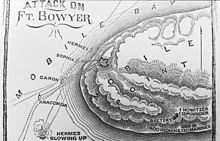Fort Bowyer
Le fort Bowyer est une fortification en terre et palissade que l'armée américaine a érigée en 1813 sur la péninsule de Mobile Point, près de l'embouchure du Mobile dans la baie de Mobile dans l'actuel comté de Baldwin, en Alabama, mais faisait alors partie du territoire du Mississippi.
| Type |
Fortification |
|---|---|
| Partie de | |
| Construction |
1813 |
| Localisation |
|---|
| Coordonnées |
|---|

Les Britanniques ont attaqué le fort à deux reprises pendant la guerre de 1812.
Histoire
modifierLe fort est dénommé en l'honneur du colonel John Bowyer.
Première attaque
modifierLa première attaque, infructueuse, a lieu en septembre 1814 et a conduit les Britanniques à changer de stratégie et à attaquer La Nouvelle-Orléans. L'attaque britannique, navale et terrestre, est connue sous le nom de « Première bataille de Fort Bowyer ».
Seconde attaque
modifierLa seconde attaque, consécutive à la bataille de La Nouvelle-Orléans, est un succès. Elle a lieu en février 1815, après la signature du traité de Gand, mais avant que la nouvelle n'atteigne cette partie de l'Amérique[1].
Démantèlement
modifierEntre 1819 et 1834, les États-Unis construisent une nouvelle fortification en maçonnerie, Fort Morgan, sur le site même de Fort Bowyer[2].
Bibliographie
modifier- Brenton, Edward Pelham (1823) The naval history of Great Britain from the year MDCCLXXXIII to MDCCCXXIII. (London : C. Rice).
- René Chartrand, Forts of the War of 1812, England, Osprey, (ISBN 978-1849085762)
- Dickson, « Artillery services in North America in 1814 and 1815. Being extracts from "Journal of Operations in Louisiana, 1814 and 1815" by Sir Alexander Dickson », Journal of the Society for Army Historical Research, part 3 of 3, February 1815, vol. 8, no 34, , p. 213–227 (JSTOR 44232284, lire en ligne [archive] )
- Eaton, John Henry, and Jerome Van Crowninshield Smith (1834) Memoirs of Andrew Jackson: late major general and commander in chief of the Southern division of the army of the United States. (Philadelphia)
- Elting, John (1995) Amateurs, to arms!: a military history of the War of 1812 (Chapel Hill : Algonquin Books)
- England, Bob, Jack Friend, Michael Bailey, and Blanton Blankenship (2000) Fort Morgan. (Charleston, CS: Arcadia).
- Fraser, Edward, & L. G. Carr-Laughton (1930). The Royal Marine Artillery 1804–1923, volume 1 1804–1859]. Londres, The Royal United Services Institution. (OCLC 4986867)
- Heidler, David Stephen & Jeanne T. Heidler (2004) Encyclopedia of the War of 1812. (Annapolis, Maryland, Naval Institute Press, 1997). (ISBN 1-59114-362-4)
- William James, The Naval History of Great Britain, Volume 6 (1811–1827), p.356., Conway Maritime Press, (1re éd. 1827) (ISBN 0-85177-909-3)
- James, William (1818) A Full and Correct Account of the Military Occurrences of the Late War Between Great Britain and the United States of America. (Londres, Printed for the Author). (ISBN 0-665-35743-5)
- Latour, Arsène Lacarrière (1816) Historical memoir of the war in West Florida and Louisiana in 1814-15. (Philadelphie, John Conrad & Co)
- Lossing, Benson John (1868) The pictorial field-book of the war of 1812: or, illustrations, by pen and pencil, of the history, biography, scenery, relics, and traditions of the last war for American independence. (New York : Harper & Bros.)
- Malcomson, Robert (2006) Historical dictionary of the War of 1812. (Lanham, Maryland : Scarecrow Press).
- Maj Gen Whitworth Porter, History of the Corps of Royal Engineers Vol I, Chatham, The Institution of Royal Engineers, (OCLC 35254552)
- Theodore Roosevelt, The Naval War of 1812, vol. II, Annapolis, Naval Institute Press, (lire en ligne [archive])
- Quimby, Robert S. (1997) The U.S. Army in the War of 1812: An Operational and Command Study. (Michigan State University Press, East Lansing, Michigan). (ISBN 0-87013-441-8)
- Remini, Robert Vincent (2001) The Battle of New Orleans. (New York : Penguin Books)
- Sugden, « The Southern Indians in the War of 1812: The Closing Phase », Florida Historical Quarterly, (lire en ligne [archive])
- Smith, « Our Flag Was Display'd within Their Works": The Treaty of Ghent and the Conquest of Mobile », Alabama Review, vol. 52, no 1, , p. 3–20
- Tucker, Spencer (ed). (2012): 'The Encyclopedia of the War of 1812: A Political, Social, and Military History'. ABC-CLIO. (ISBN 1851099565)
Notes et références
modifier- Heidler (2004), p.115.
- (en) « National Register Information System [archive] », sur le site du National Park Service, National Register of Historic Places,
Liens externes
modifier
- Notice dans un dictionnaire ou une encyclopédie généraliste :
- mywarof1812.com [archive]
- 1812casualties.org [archive]
- Attaque de Fort Bowyer Septembre 1814
